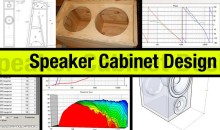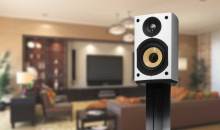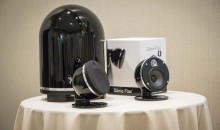Genelec G Five Review – Premiere Powered Speakers
The G Five speakers aren't necessarily "better" than the G Four's, they're just more capable. They have greater output, play deeper, and can fill a larger room. And that's what makes them great.
When I graduated college I quickly landed a job at a post production studio where I’d spend the next 7 years of my life working on movies, television and theme parks. We actually got by on a very minimal amount of gear—relying on our ears and our understanding of how things sounded in the rooms we were in to select and edit sound effects and also to mix soundtracks. I remember the day a pair of Genelec speakers made their way into the studio. All work stopped as our studio engineer quickly got them wired up and situated in our largest mix room. If I’m not mistaken (it was a long time ago), they were a pair of 1030A bi-amplified studio monitors. They sounded fantastic, and my very personal introduction to the Genelec brand had begun. The new Genelec G Five speakers look nothing like those speakers I used in my studio days. The G Five’s have a gently curved die-cast aluminum enclosure that is seamed in the center. The shape, which looks almost futuristic—as if it belonged in the next Bond film as part of some sonic-based torture device—is designed that way for more than just aesthetics. The smooth contours also served to reduce internal diffractions which act upon the drivers and generate micro distortion in the generated audio. If this Genelec G Series review does anything, it will demonstrate just how clean these speakers are—and not just in the looks department.
 Based in Iisalmi, Finland, Genelec has a long history of making great speakers They go back much farther than my experience with them in the early 90’s, debuting in 1978. While Gene;ex’s primary focus has been studio monitors and the pro audio world, this new G Series line is a new consumer line that delivers Genelec’s signature design into the consumer market. The Genelec G Series includes five active loudspeakers that range in size, output, and frequency response from the G One all the way to this flagship model, the G Five. The G Five puts out a lot of sound. With a maximum output rating of 110 dB SPL, it will fill all but the largest and most dampened rooms. I’ve used and listened to much larger speakers (both active and passive) that couldn’t generate the amount of sound these powered monitors can. The G Five also distinguishes itself in the line by reaching down further and deeper than its brethren—all the way to 35 Hz as matter of fact (-3dB). For comparison, the G One goes down to just 73 Hz and the G Four dips down to 45Hz. You get a full 10 Hz gain in low frequency response from the G Five speakers, mostly due to the larger enclosure and that 8-inch woofer. Indeed, the G Five has over 9 pounds on the G Four.
Based in Iisalmi, Finland, Genelec has a long history of making great speakers They go back much farther than my experience with them in the early 90’s, debuting in 1978. While Gene;ex’s primary focus has been studio monitors and the pro audio world, this new G Series line is a new consumer line that delivers Genelec’s signature design into the consumer market. The Genelec G Series includes five active loudspeakers that range in size, output, and frequency response from the G One all the way to this flagship model, the G Five. The G Five puts out a lot of sound. With a maximum output rating of 110 dB SPL, it will fill all but the largest and most dampened rooms. I’ve used and listened to much larger speakers (both active and passive) that couldn’t generate the amount of sound these powered monitors can. The G Five also distinguishes itself in the line by reaching down further and deeper than its brethren—all the way to 35 Hz as matter of fact (-3dB). For comparison, the G One goes down to just 73 Hz and the G Four dips down to 45Hz. You get a full 10 Hz gain in low frequency response from the G Five speakers, mostly due to the larger enclosure and that 8-inch woofer. Indeed, the G Five has over 9 pounds on the G Four.
While you can certainly add a subwoofer to the G Five system, you almost don’t have to. But bass isn’t the only thing I look for in a pair of powered speakers. The G Five speakers increase the tweeter to a 1″ aluminum dome model—important for handling that additional required 5 dB SPL of output capability, and for allowing the crossover to drop down to 1.8kHz (required with the larger diameter mid-bass driver). And customization is important as well—particularly since I tend to place bookshelf speakers on stands, but near boundaries like walls. With the Genelec G Five speakers, you get Low bass, Bass, and Treble adjustments that really help you customize the sound in your room. The following table will help you understand how the various settings can be utilized in your room:

Looking at the chart, Tabletop mode is where you’d activate none of the EQ functions, but flip the Tabletop switch to minimize the effect generated by placing the powered speaker on a hard, reflective surface. It will drop out about 4 dB from the 160-200 Hz bass region which tends to get accentuated with this type of placement. The “Treble” adjustment lets you compensate for brighter or overly dampened rooms by either removing 2 dB or 4 dB from the high end or boosting it by 2 dB. The “Bass” control only offers attenuation, which can be set in the default position, or used to remove 2, 4, or 6 dB. These modes affect bass frequencies below 1 kHz and are handy when the Genelec’s are placed too close to a wall or corner. The Low Bass control is an additional way to tune the system in areas where the deep bass frequencies are stronger than desired. Like the “Bass” control, The G Five can reduce this deeper bass by either 2, 4, or 6 dB. All of these tone controls function via dip switches and come set to no attenuation by default.
Listening Tests – Movies
 One of the advantages to having edited sound for several feature films is understanding what elements went into those films—whether they were added by me or one of my coworkers. That gives me a unique opportunity to have some fun reflecting on days past with some feature films I was involved in editing. First up was TimeCop, a film whose dialogue I was involved in editing. While the dialogue wasn’t terribly exciting to listen to, there are several great fight scenes and tons of sci-fi effects (like the first take off of the time capsule) which showed off the dynamics and the bass capabilities of the Genelec G Five speakers. To detail a particular scene, the fight scene at the end of the movie, where Jean-Claude Van Damme takes out the two bad guys from his past, features outdoor rain which the Genelec speakers reproduced with almost three-dimensional clarity. The indoor fight scene had palpable punches and kicks, and the sound effects I remember from the studio were as pristine as when they were edited and previewed in the small mix suites in which I spent so many hours. It was a great trip down memory lane—made all the better by the accuracy and dynamics of the Genelec G Five speakers.
One of the advantages to having edited sound for several feature films is understanding what elements went into those films—whether they were added by me or one of my coworkers. That gives me a unique opportunity to have some fun reflecting on days past with some feature films I was involved in editing. First up was TimeCop, a film whose dialogue I was involved in editing. While the dialogue wasn’t terribly exciting to listen to, there are several great fight scenes and tons of sci-fi effects (like the first take off of the time capsule) which showed off the dynamics and the bass capabilities of the Genelec G Five speakers. To detail a particular scene, the fight scene at the end of the movie, where Jean-Claude Van Damme takes out the two bad guys from his past, features outdoor rain which the Genelec speakers reproduced with almost three-dimensional clarity. The indoor fight scene had palpable punches and kicks, and the sound effects I remember from the studio were as pristine as when they were edited and previewed in the small mix suites in which I spent so many hours. It was a great trip down memory lane—made all the better by the accuracy and dynamics of the Genelec G Five speakers.
 I also queued up Live Die Repeat: Edge of Tomorrow on Blu-ray, which had a ridiculous amount of explosions and very dynamic effects. My favorite scenes, though brief, are the training sequences where Cruise and Blunt’s characters are practicing with flying “training propellers”. These swept left and right across the soundstage with such precision I wondered if the Genelec’s had some extra 3D DSP I hadn’t been made aware of (they don’t). The truth is, a great environmental stereo mix can put forth very realistic depth with speakers that have excellent imaging and fidelity. Of course, this scene also had deep bass drops that came in, for example, when Cruise was struck and paralyzed by one of the trainers. The Genelec G Five speakers certainly made this movie truly immersive, even in stereo. In one of the later scenes when Tom Cruise’s character walks through the battlefield, seemingly clairvoyant of all that is about to occur, he fires his weapon and the subsequent automatic fire and explosions, along with the aliens being ripped apart made for a great experience a I listened. In fact, I could watch this movie with my eyes closed and follow nearly every bit of the action without seeing a thing. It’s something I can’t say about all movies, and certainly not with all speakers. Bass and localization are top shelf with the G Five’s, and when I turned my attention towards music, it got even better.
I also queued up Live Die Repeat: Edge of Tomorrow on Blu-ray, which had a ridiculous amount of explosions and very dynamic effects. My favorite scenes, though brief, are the training sequences where Cruise and Blunt’s characters are practicing with flying “training propellers”. These swept left and right across the soundstage with such precision I wondered if the Genelec’s had some extra 3D DSP I hadn’t been made aware of (they don’t). The truth is, a great environmental stereo mix can put forth very realistic depth with speakers that have excellent imaging and fidelity. Of course, this scene also had deep bass drops that came in, for example, when Cruise was struck and paralyzed by one of the trainers. The Genelec G Five speakers certainly made this movie truly immersive, even in stereo. In one of the later scenes when Tom Cruise’s character walks through the battlefield, seemingly clairvoyant of all that is about to occur, he fires his weapon and the subsequent automatic fire and explosions, along with the aliens being ripped apart made for a great experience a I listened. In fact, I could watch this movie with my eyes closed and follow nearly every bit of the action without seeing a thing. It’s something I can’t say about all movies, and certainly not with all speakers. Bass and localization are top shelf with the G Five’s, and when I turned my attention towards music, it got even better.
Listening Tests – Music
 Switching over to some classical music, I recognized just how critical placement of these speakers is. Should you have them toed in too far, you risk collapsing the soundstage and narrowing your stereo image. Instead, these powered bookshelf speakers can handle being toed in less, and allowing for a much wider spread of sound into the room. Provided the distance between you and the speakers is greater than the distance these speakers are apart, I recommend very little toe-in. That changes, of course, if you’re utilizing them at a desk or in very close quarters (though, honestly, Id likely recommend the Genelec G Three or G Two speakers for those situations). Vivaldi’s “Four Seasons: Concerto No. 2 in G Minor” is a very aggressive string piece, sort of like the audio equivalent of Class 5+ rapids. I love the way the G Five speakers, perfectly imaged, reproduced the effect of sitting in front of a live performance of this piece. The soundstage was considerably wider than the distance between the speakers, and the depth of the stereo image also exceeded the space. In my room, I was taken away to a concert hall where I enjoyed a brief respite of time enjoying this amazing violin concerto.
Switching over to some classical music, I recognized just how critical placement of these speakers is. Should you have them toed in too far, you risk collapsing the soundstage and narrowing your stereo image. Instead, these powered bookshelf speakers can handle being toed in less, and allowing for a much wider spread of sound into the room. Provided the distance between you and the speakers is greater than the distance these speakers are apart, I recommend very little toe-in. That changes, of course, if you’re utilizing them at a desk or in very close quarters (though, honestly, Id likely recommend the Genelec G Three or G Two speakers for those situations). Vivaldi’s “Four Seasons: Concerto No. 2 in G Minor” is a very aggressive string piece, sort of like the audio equivalent of Class 5+ rapids. I love the way the G Five speakers, perfectly imaged, reproduced the effect of sitting in front of a live performance of this piece. The soundstage was considerably wider than the distance between the speakers, and the depth of the stereo image also exceeded the space. In my room, I was taken away to a concert hall where I enjoyed a brief respite of time enjoying this amazing violin concerto.
 There’s a lot to be said about a speaker that can faithfully reproduce the delicate soundstage of a live performance. For more of this I turned to the performance of Peter Gabriel and Youssou N’Dour’s 1988 performance of “In Your Eyes”. The percussion in this track was split between the left and right sides of the stage, and the combined vocals were very raw and, though somewhat recessed in the mix (no fault of the Genelec’s), they were also stripped raw of much of the synthetic “cleanliness” applied in the studio mix. The larger 1″ tweeter really takes on a larger role in this system over the other G Series speakers, and it really handled itself well in this recording.
There’s a lot to be said about a speaker that can faithfully reproduce the delicate soundstage of a live performance. For more of this I turned to the performance of Peter Gabriel and Youssou N’Dour’s 1988 performance of “In Your Eyes”. The percussion in this track was split between the left and right sides of the stage, and the combined vocals were very raw and, though somewhat recessed in the mix (no fault of the Genelec’s), they were also stripped raw of much of the synthetic “cleanliness” applied in the studio mix. The larger 1″ tweeter really takes on a larger role in this system over the other G Series speakers, and it really handled itself well in this recording.
 For an emphasis on male vocals, one of my favorite targets, I sent the Genelec G Five speakers one DTS audio from Seal IV, beginning with “Love’s Divine”. The reverb literally poured off Seal’s vocals and spread outward to the left and right speakers equally—like a ripple in a pond. The Genelec G Five’s produced a soundstage that didn’t give up even a tiny bit of the roomy effects. This is a very intimate mix, and if you don’t have the finesse to hear the detail, the result can be a very flat and punchy track that lacks the true depth an intimacy of the original mix. In reality, the simplicity of the early mix and the subsequent built and bass line make this one of the coolest male vocal tracks I know. I played this several times before letting it play into “Waiting For You”, a bigger track with a lot of different elements that can quickly gang up and become compressed-sounding on systems that can’t afford the various pockets each instrument needs to fit into. I loved the funky bass that permeates the entire track, and the bridge—with its string section and stark drum track—provided a great pause to the thick mix. A song like this can sound a bit dense on the Genelec G Five speakers unless you have a room that can be filled with their massive and dynamic output. This is where speaker selection is important—the biggest isn’t always the best. In my office the Genelec’s were slightly overwhelming, but in my primary listening room they filled the area nicely and opened up, letting me enjoy every bit of what they had to offer.
For an emphasis on male vocals, one of my favorite targets, I sent the Genelec G Five speakers one DTS audio from Seal IV, beginning with “Love’s Divine”. The reverb literally poured off Seal’s vocals and spread outward to the left and right speakers equally—like a ripple in a pond. The Genelec G Five’s produced a soundstage that didn’t give up even a tiny bit of the roomy effects. This is a very intimate mix, and if you don’t have the finesse to hear the detail, the result can be a very flat and punchy track that lacks the true depth an intimacy of the original mix. In reality, the simplicity of the early mix and the subsequent built and bass line make this one of the coolest male vocal tracks I know. I played this several times before letting it play into “Waiting For You”, a bigger track with a lot of different elements that can quickly gang up and become compressed-sounding on systems that can’t afford the various pockets each instrument needs to fit into. I loved the funky bass that permeates the entire track, and the bridge—with its string section and stark drum track—provided a great pause to the thick mix. A song like this can sound a bit dense on the Genelec G Five speakers unless you have a room that can be filled with their massive and dynamic output. This is where speaker selection is important—the biggest isn’t always the best. In my office the Genelec’s were slightly overwhelming, but in my primary listening room they filled the area nicely and opened up, letting me enjoy every bit of what they had to offer.
 Then I switched over to Lacrae, with “Say I Won’t” on his Anomaly album. The drop-in synth bass in this track isn’t just low, it’s got a lot of square wave effects that really try the quickness of your low frequency driver. The 8″ woofer on the G Five pumped out the bass like a pair of 12″ woofers in the back of a show car. There are several “breaks” in this tune where the bass hits a sudden dive into the 25 Hz region, and it was awesome to hear the Genelec’s plow right through—as if saying “Is that all you’ve got?” Apparently, these speakers have a lot more to give than even I anticipated. In fact, even with lower resolution streaming music from Spotify, the Genelec’s continued to impress.
Then I switched over to Lacrae, with “Say I Won’t” on his Anomaly album. The drop-in synth bass in this track isn’t just low, it’s got a lot of square wave effects that really try the quickness of your low frequency driver. The 8″ woofer on the G Five pumped out the bass like a pair of 12″ woofers in the back of a show car. There are several “breaks” in this tune where the bass hits a sudden dive into the 25 Hz region, and it was awesome to hear the Genelec’s plow right through—as if saying “Is that all you’ve got?” Apparently, these speakers have a lot more to give than even I anticipated. In fact, even with lower resolution streaming music from Spotify, the Genelec’s continued to impress.
Conclusion
I love that Genelec took something that was great, and made it even more capable. The G Five speakers aren’t necessarily “better” than the G Four’s, they’re just more capable. They have greater output, play deeper, and can fill a larger room. For those who have the space to fit them I know you won’t be disappointed with the results. Squeeze these into a small studio or office, and you may just regret not matching the system to your needs. And that’s what makes Genelec a great brand—you get your choice.
Genelec G Five Specifications
- Maximum SPL: 110 dB
- Frequency response: 35 Hz – 21 kHz (-3 dB)
- Crossover (± 2.5 dB): 38 Hz – 20kHz
- Crossover frequency: 1.8 kHz
- Woofer: 8″
- Tweeter: 1″ metal dome + Directivity Control Waveguide (DCW)
- Amplifier power: 150 W (woofer) + 120 W (tweeter)
- Dimensions: 17 13/16″ H x 11 1/4″ W x 10 15/16″ D, with Iso-Pod
- Weight: 28 lbs (12.7 kg)
- Inputs: RCA, XLR










Genelec
Retail: $2595.00 each.
Will these speakers be enough for a home theater 25 feet (7.6m) by 16 feet (4.9m)?
The ratings show that these speakers disappoint in mids and highs. But nothing in the writeup confirms that, it instead glows about detail. Which is it?